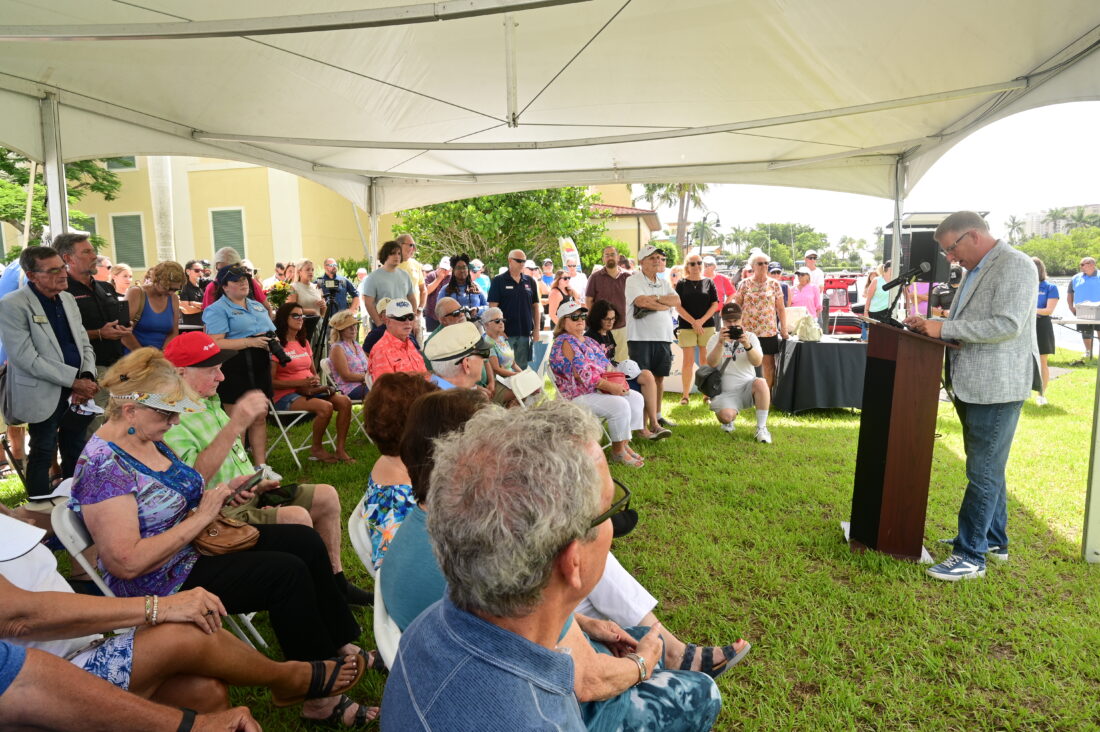City celebrates removal of the Chiquita Lock
'Unblock the Lock" block party & ribbon cutting draws supporters
The city of Cape Coral celebrated the removal of the Chiquita Lock last Friday with an “Unblock the Lock” block party and ribbon cutting.
The ceremony along the South Spreader canal at 5781 Cape Harbour Drive had been years — and a pair of environmental lawsuits — in the making.
Among those happy to see the waterway unobstructed was City Manager Michael Ilczyszyn, who began his career with the city in 2002 which began its efforts to remove the device in 2006.
The lock, part of a decades-old consent order related to the un-permitted dredging of Cape canals, was originally intended to keep pollutants from stormwater runoff out of the Caloosahatchee estuary.
Although environmentalists, some residents including the “Three Fishermen” who sued the city, and environmental organizations including the Sanibel-Captiva Conservation Foundation opposed its removal for that reason, the city has long contended that the lock had outlived its usefulness and its removal would not harm the river.
Ilczyszyn gave a simple explanation of the mechanism and why the city worked so long to get it removed.
“A canal lock is a method of transferring vessels from two elevations,” he said. “We had manatees, dolphins and fish, getting crushed inside of the lock. Removing the gates from this area was really just about common sense.” Ilczyszyn said.
To mitigate the potential of water quality impacts, city officials will now deploy oyster reef balls and plant thousands of additional mangroves.
“This waterway is ready for the city’s future,” Ilczyszyn said.
In attendance at the block party were both former and current city council members, environmental biologist Harry Phillips, Cape Coral Mayor John Gunter, Fred Edman, president of Wright Construction — the company charged with removing the Chiquita Lock — and more than 40 community supporters.
“There was a large amount of civilian support for this,” Gunter said.
He thanked Wright Construction for its efficiency in competing removal of the lock ahead of schedule.
Edman said his company, which employees more than 70 people, had a lot of support for this project.
“Some of our employees are volunteering next week, and coming out here to plant mangroves,” Edman added.
Ron Austin is a Cape Coral resident who, Ilczyszyn said, never gave up on his advocacy for removing the Chiquita Lock. Austin beamed as Gunter cut the ceremonial red ribbon.
“The lock was aging,” Austin said. “We once saw a dead manatee cow lying in the shallow water. There was barbed wire and debris. It was just incredibly unsafe.”
Other residents agreed it was a day overdue.
Neighbors Anne McCormick and Kathy and Chris Scott brought lawn chairs, plastic wine flutes and a bottle of champagne to celebrate the removal of the water control structure that had been inoperable since Hurricane Ian. Following the official ribbon cutting, they raised their glasses in a hearty toast.
McCormick said she is a former chemist and believes the area will be more environmentally sound.
“The three of us live on the water behind the former Chiquita Lock,” she said. “I know of eight manatees who
were crushed. The lock was a real safety hazard, and the word I have today is grateful. We are just so grateful to former and current city council members who made the canal safe again.
The day’s festivities, which included a buffet by Mission BBQ, culminated with Phillips and Cape Coral environmental technicians taking a small watercraft across the canal and planting mangroves along the waterway.
Meanwhile, throughout the morning, boats passed slowly through the open waterway.
Along with being environmentally important, Austin said the lock-free canal is now much easier to navigate in a boat. Austin speaks from the experience of captaining a 50-foot-long craft through the now unblocked lock.









